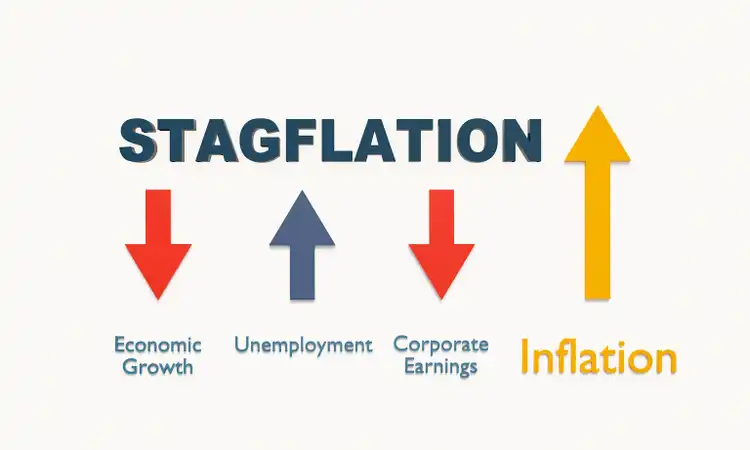What is stagflation?
Stagflation is a condition in which slow economic growth (stagnation), rising prices (inflation), and rising unemployment all happen at the same time. Although it is rare for slow economic growth and high inflation to coexist, it has happened in the past, and many believe it could happen again.
Stagflation has occurred twice in the U.S., once between 1974 and 1975 and again between 1978 and 1982. All of this happened during a period known as the Great Inflation (1965 to 1982).
When stagflation is present, workers make less money but have to pay more for the things they buy. Investors see lower returns due to slow growth, and the longer stagflation continues, the more it impacts the future value of their investments.

How stagflation works
The key to how stagflation works is found in the three economic forces that make it up: stagnation, high inflation, and high unemployment. In a stagnant economy, slow growth results in high unemployment. With more people seeking fewer jobs, lower wages result. At the same time, high inflation causes the prices of goods and services to go up, reducing the purchasing power of consumers.
Investors suffer losses since both bonds and stocks underperform during stagflation. Lack of growth suppresses stock prices while high inflation has a negative impact on bonds.
The Federal Reserve’s response to stagflation in the 1970s was to increase government spending as a way to achieve full employment. This policy created higher inflation but failed to solve the employment problem. The Great Inflation ended in global recession, a period of sustained low or negative economic growth and high unemployment. Whether today’s economy would suffer the same fate during a period of stagflation remains to be seen.
What causes stagflation?
Although there is no consensus among economists about the causes of stagflation, two theories are mentioned more frequently than others. They are shocks to the supply chain, especially with commodities including oil, and poor monetary policies.
Supply chain shocks
Anything that lowers the economy’s ability to produce goods and services can be a supply chain shock. The Great Inflation was subject to two supply chain shocks related to oil shortages. One was the Arab oil embargo of 1973–1974, the other the 1978–1979 shock that took place with the fall of the Shah of Iran.
“The shocks came from a dramatic increase in oil prices during those periods which drove up costs,” says Gary Zimmerman, founder and CEO of MaxMyInterest, a cash management platform for investors. “Companies said, ‘If my energy costs are going up, I can at least control my labor costs.’ At this point slow growth, high unemployment, and inflation were in play.”
Poor monetary policies
Stagflation is a real problem for policy makers because the Central Bank can increase interest rates to reduce inflation or cut interest rates to reduce unemployment. It cannot, however, do both at the same time.
During stagflation of the 1970s, the Fed, in an attempt to create full employment, increased the money supply. This had the effect of feeding fuel to inflation without reducing unemployment. Bad understanding of data was also a problem in the 1970s. Estimates of output (production) were understated and estimates of unemployment rates were significantly overstated.
“Given the current environment and stated Fed policies, it is unlikely that monetary policy alone would incite stagflation today,” says Cristian deRitis, deputy chief economist at Moody’s Analytics. “Some other shock, such as an energy price shock or supply-chain shock, would be needed to take the Federal Reserve off of its chartered course and create the conditions for stagflation.”

What is the difference between stagflation and inflation?
Inflation is both a component of stagflation and an economic event in and of itself. As noted before, stagflation has three components: economic growth, inflation, and unemployment. How these components perform during a given economic event (stagflation or inflation) illustrates the main differences between the two events.
As the table below shows, stagflation is characterized by a decrease in economic growth (stagnation), an increase in inflation, and an increase in unemployment. During periods of inflation, both economic growth and inflation rise while unemployment goes down.
How can you prepare for stagflation?
At a macroeconomic level, we can encourage policymakers to take anti-stagflationary steps such as trying to reduce the economy’s dependence on oil, since rising oil prices are a major contributor to stagflation. Policies to increase economic growth and productivity also help.
“In addition, investors may want to consider the possibility of a ‘low-grade’ stagflation scenario where inflation moderates to 4% but unemployment rises to 5%,” suggests deRitis. “While the Federal Reserve may still be committed to fighting inflation, it may face pressure to address the second part of its mandate: full employment. As a result, it may adopt more accommodative monetary policy that allows inflation to remain above its 2% target for an extended period of time—perhaps indefinitely.”
Suggested strategies and actions that can help temper the impact of stagflation include:
- Buy TIPS. TIPS stands for Treasury Inflation-Protected Securities. These are government bonds that mirror the rise and fall of inflation.
- Reduce debt. Today’s high interest rates make short-term loans and credit card debt a no-no.
- Put off major purchases. This is especially true if the plan includes tapping into investments or long-term savings.
- Keep your job. Stagflation means a tight job market. “A job generates income and keeping it is the most important thing to do if we’re heading into a period of stagflation,” notes Zimmerman.
- Invest in gold, commodities, and real estate. During periods of stagflation, these are the top performers.
source

